Temporary Facility Location Problem in Humanitarian Logistics: A Systematic Literature Review
Abstract
:1. Introduction
Research Objectives and Main Contributions
- It systematically reviews and consolidates existing research on temporary facility location problems in humanitarian logistics, providing a structured synthesis of key findings in the field.
- It highlights current trends in the literature, offering insights into the predominant themes and focal areas of recent studies.
- It identifies critical research gaps and suggests avenues for future research to enhance the effectiveness of temporary facility location strategies.
2. Method
- Did not focus on location problems.
- Did not focus on temporary or modular facilities.
- Did not pertain to humanitarian logistics.
- Primarily addressed disaster risk mapping, vulnerability assessment, or waste management.
- General Information: Includes journal name, country of the case study, and year of publication.
- Humanitarian logistic related information: Specifies the type of disaster and the type of temporary facility being located.
- Objective Function: Identifies whether the model is single-objective or multi-objective and categorizes the type of objective function used [3].
- Capacity Constraints: Differentiates between capacitated and uncapacitated facility location models [1].
- Planning Horizon: Classifies models as single-period, multi-period, or continuous-time [3].
- Uncertainty Consideration: Determines whether the model explicitly accounts for uncertainty using probability distributions [3].
- Mathematical Modeling Approach: Identifies whether the model employs linear or nonlinear programming, as well as methodologies, such as deterministic optimization, robust programming, stochastic programming, fuzzy programming, or goal programming [3].
- Solution Approach: Specifies whether solutions were obtained using commercial solvers, metaheuristic algorithms, Lagrangian relaxation, or other techniques [3].
- Location Problem Decisions: Examines decisions related to facility opening, operation, and closure [3].
- Modular Capacity Planning Decisions: Includes decisions regarding facility configuration, relocation, expansion, reduction, and operation of modular units [3].
3. Results
3.1. General Information
3.2. Humanitarian Logistics-Related Information
3.3. Customer Demand
3.4. Objective Function
3.5. Capacity Constraints
3.6. Planning Horizon
3.7. Uncertainty
3.8. Mathematical Modeling
3.9. Solution Approach
3.10. Location Problem Decisions
3.11. Modular Capacity Planning Decisions
4. Discussion
5. Conclusions
5.1. Theoretical Considerations
5.2. Limitations
5.3. Future Research Directions
Supplementary Materials
Author Contributions
Funding
Data Availability Statement
Conflicts of Interest
References
- Daskin, M.S. Network and Discrete Location: Models, Algorithms, and Applications, 2nd ed.; John Wiley & Sons, Inc.: Hoboken, NJ, USA, 2013. [Google Scholar] [CrossRef]
- Farahani, R.Z.; Fallah, S.; Ruiz, R.; Hosseini, S.; Asgari, N. OR models in urban service facility location: A critical review of applications and future developments. Eur. J. Oper. Res. 2019, 276, 1–27. [Google Scholar] [CrossRef]
- Alarcon-Gerbier, E.; Buscher, U. Modular and mobile facility location problems: A systematic review. Comput. Ind. Eng. 2022, 173, 108734. [Google Scholar] [CrossRef]
- Ehsani, B.; Karimi, H.; Bakhshi, A.; Aghsami, A.; Rabbani, M. Designing humanitarian logistics network for managing epidemic outbreaks in disasters using Internet-of-Things. A case study: An earthquake in Salas-e-Babajani city. Comput. Ind. Eng. 2023, 175, 108821. [Google Scholar] [CrossRef] [PubMed]
- EM-DAT. 2023 Disaster in Numbers. 2024. Available online: https://files.emdat.be/reports/2023_EMDAT_report.pdf (accessed on 18 March 2025).
- Thomas, A.S.; Kopczak, L.R. From logistics to supply chain management: The path forward in the humanitarian sector. Fritz Inst. 2005, 15, 1–15. [Google Scholar]
- Van Wassenhove, L.N. Humanitarian aid logistics: Supply chain management in high gear. J. Oper. Res. Soc. 2006, 57, 475–489. [Google Scholar] [CrossRef]
- Holguín-Veras, J.; Jaller, M.; Van Wassenhove, L.N.; Pérez, N.; Wachtendorf, T. On the unique features of post-disaster humanitarian logistics. J. Oper. Manag. 2012, 30, 494–506. [Google Scholar] [CrossRef]
- Rawls, C.G.; Turnquist, M.A. Pre-positioning and dynamic delivery planning for short-term response following a natural disaster. Socio-Econ. Plan. Sci. 2012, 46, 46–54. [Google Scholar] [CrossRef]
- Long, S.; Zhang, D.; Liang, Y.; Li, S.; Chen, W. Robust Optimization of the Multi-Objective Multi-Period Location-Routing Problem for Epidemic Logistics System with Uncertain Demand. IEEE Access 2021, 9, 151912–151930. [Google Scholar] [CrossRef]
- Maharjan, R.; Hanaoka, S. A multi-actor multi-objective optimization approach for locating temporary logistics hubs during disaster response. J. Humanit. Logist. Supply Chain. Manag. 2018, 8, 2–21. [Google Scholar] [CrossRef]
- Chen, Z.; Chen, X.; Li, Q.; Chen, J. The temporal hierarchy of shelters: A hierarchical location model for earthquake-shelter planning. Int. J. Geogr. Inf. Sci. 2013, 27, 1612–1630. [Google Scholar] [CrossRef]
- Kitchenham, B.; Brereton, O.P.; Budgen, D.; Turner, M.; Bailey, J.; Linkman, S. Systematic literature reviews in software engineering–a systematic literature review. Inf. Softw. Technol. 2009, 51, 7–15. [Google Scholar] [CrossRef]
- Banomyong, R.; Varadejsatitwong, P.; Oloruntoba, R. A systematic review of humanitarian operations, humanitarian logistics and humanitarian supply chain performance literature 2005 to 2016. Ann. Oper. Res. 2019, 283, 71–86. [Google Scholar] [CrossRef]
- Page, M.J.; McKenzie, J.E.; Bossuyt, P.M.; Boutron, I.; Hoffmann, T.C.; Mulrow, C.D.; Shamseer, L.; Tetzlaff, J.M.; Akl, E.A.; Brennan, S.E.; et al. The PRISMA 2020 statement: An updated guideline for reporting systematic reviews. BMJ 2021, 372, n71. [Google Scholar] [CrossRef] [PubMed]
- Page, M.J.; Moher, D.; Bossuyt, P.M.; Boutron, I.; Hoffmann, T.C.; Mulrow, C.D.; Shamseer, L.; Tetzlaff, J.M.; Akl, E.A.; Brennan, S.E.; et al. PRISMA 2020 explanation and elaboration: Updated guidance and exemplars for reporting systematic reviews. BMJ 2021, 372, n160. [Google Scholar] [CrossRef]
- Mongeon, P.; Paul-Hus, A. The journal coverage of Web of Science and Scopus: A comparative analysis. Scientometrics 2016, 106, 213–228. [Google Scholar] [CrossRef]
- Leiras, A.; de Brito, I., Jr.; Queiroz Peres, E.; Rejane Bertazzo, T.; Tsugunobu Yoshida Yoshizaki, H. Literature review of humanitarian logistics research: Trends and challenges. J. Humanit. Logist. Supply Chain. Manag. 2014, 4, 95–130. [Google Scholar] [CrossRef]
- Macit, B.; Demirel, N.; Demirel, E.; Gökçen, H. Mathematical Modeling Approach for Emergency Education of Refugees in Developing Countries. Int. J. Ind. Eng. 2022, 29, 649–670. [Google Scholar] [CrossRef]
- Kilci, F.; Kara, B.Y.; Bozkaya, B. Locating temporary shelter areas after an earthquake: A case for Turkey. Eur. J. Oper. Res. 2015, 243, 323–332. [Google Scholar] [CrossRef]
- Hallak, J.; Koyuncu, M.; Miç, P. Determining shelter locations in conflict areas by multiobjective modeling: A case study in northern Syria. Int. J. Disaster Risk Reduct. 2019, 38, 101202. [Google Scholar] [CrossRef]
- Afshar, A.; Haghani, A. Modeling integrated supply chain logistics in real-time large-scale disaster relief operations. Socio-Econ. Plan. Sci. 2012, 46, 327–338. [Google Scholar] [CrossRef]
- Liu, Y.; Zhang, T.; Lei, H.; Guo, B. Stochastic programming approach for earthquake disaster relief mobilization with multiple objectives. J. Syst. Eng. Electron. 2013, 24, 642–654. [Google Scholar] [CrossRef]
- Mahtab, Z.; Azeem, A.; Ali, S.M.; Paul, S.K.; Fathollahi-Fard, A.M. Multi-objective robust-stochastic optimisation of relief goods distribution under uncertainty: A real-life case study. Int. J. Syst. Sci. Oper. Logist. 2022, 9, 241–262. [Google Scholar] [CrossRef]
- Khayal, D.; Pradhananga, R.; Pokharel, S.; Mutlu, F. A model for planning locations of temporary distribution facilities for emergency response. Socio-Econ. Plan. Sci. 2015, 52, 22–30. [Google Scholar] [CrossRef]
- Cavdur, F.; Kose-Kucuk, M.; Sebatli, A. Allocation of temporary disaster response facilities under demand uncertainty: An earthquake case study. Int. J. Disaster Risk Reduct. 2016, 19, 159–166. [Google Scholar] [CrossRef]
- Loree, N.; Aros-Vera, F. Points of distribution location and inventory management model for Post-Disaster Humanitarian Logistics. Transp. Res. Part E Logist. Transp. Rev. 2018, 116, 1–24. [Google Scholar] [CrossRef]
- Liu, Y.; Cui, N.; Zhang, J. Integrated temporary facility location and casualty allocation planning for post-disaster humanitarian medical service. Transp. Res. Part E Logist. Transp. Rev. 2019, 128, 1–16. [Google Scholar] [CrossRef]
- Sun, H.; Li, J.; Wang, T.; Xue, Y. A novel scenario-based robust bi-objective optimization model for humanitarian logistics network under risk of disruptions. Transp. Res. Part E Logist. Transp. Rev. 2022, 157, 102578. [Google Scholar] [CrossRef]
- Wang, J.; Wang, Y.; Yu, M. A multi-period ambulance location and allocation problem in the disaster. J. Comb. Optim. 2022, 43, 909–932. [Google Scholar] [CrossRef]
- Stauffer, J.M.; Pedraza-Martinez, A.J.; Wassenhove, L.N.V. Temporary Hubs for the Global Vehicle Supply Chain in Humanitarian Operations. Prod. Oper. Manag. 2016, 25, 192–209. [Google Scholar] [CrossRef]
- Maharjan, R.; Hanaoka, S. Fuzzy multi-attribute group decision making to identify the order of establishing temporary logistics hubs during disaster response. J. Humanit. Logist. Supply Chain. Manag. 2019, 9, 2–21. [Google Scholar] [CrossRef]
- Khalilpourazari, S.; Soltanzadeh, S.; Weber, G.W.; Roy, S.K. Designing an efficient blood supply chain network in crisis: Neural learning, optimization and case study. Ann. Oper. Res. 2020, 289, 123–152. [Google Scholar] [CrossRef]
- Maharjan, R.; Hanaoka, S. A credibility-based multi-objective temporary logistics hub location-allocation model for relief supply and distribution under uncertainty. Socio-Econ. Plan. Sci. 2020, 70, 100727. [Google Scholar] [CrossRef]
- Oksuz, M.K.; Satoglu, S.I. A two-stage stochastic model for location planning of temporary medical centers for disaster response. Int. J. Disaster Risk Reduct. 2020, 44, 101426. [Google Scholar] [CrossRef]
- Yenice, Z.D.; Samanlioglu, F. A Multi-Objective Stochastic Model for an Earthquake Relief Network. J. Adv. Transp. 2020, 2020, 1910632. [Google Scholar] [CrossRef]
- Zhou, Y.; Lee, G.M. A Bi-Objective Medical Relief Shelter Location Problem Considering Coverage Ratios. Int. J. Ind. Eng. 2020, 27, 971–988. [Google Scholar]
- Alem, D.; Bonilla-Londono, H.F.; Barbosa-Povoa, A.P.; Relvas, S.; Ferreira, D.; Moreno, A. Building disaster preparedness and response capacity in humanitarian supply chains using the Social Vulnerability Index. Eur. J. Oper. Res. 2021, 292, 250–275. [Google Scholar] [CrossRef]
- Alizadeh, R.; Nishi, T.; Bagherinejad, J.; Bashiri, M. Multi-period maximal covering location problem with capacitated facilities and modules for natural disaster relief services. Appl. Sci. 2021, 11, 397. [Google Scholar] [CrossRef]
- Chen, A.Y.; Yu, T.Y. Network based temporary facility location for the Emergency Medical Services considering the disaster induced demand and the transportation infrastructure in disaster response. Transp. Res. Part B Methodol. 2016, 91, 408–423. [Google Scholar] [CrossRef]
- Beiki, H.; Seyedhosseini, S.M.; Mihardjo, L.W.; Seyedaliakbar, S.M. Multiobjective location-routing problem of relief commodities with reliability. In Environmental Science and Pollution Research; Springer: Berlin/Heidelberg, Germany, 2021. [Google Scholar] [CrossRef]
- Saeidian, B.; Mesgari, M.S.; Ghodousi, M. Evaluation and comparison of Genetic Algorithm and Bees Algorithm for location-allocation of earthquake relief centers. Int. J. Disaster Risk Reduct. 2016, 15, 94–107. [Google Scholar] [CrossRef]
- Gai, L.; Peng, Z.; Zhang, J.; Zhang, J. Emergency medical center location problem with people evacuation solved by extended TODIM and objective programming. J. Comb. Optim. 2021, 42, 1004–1029. [Google Scholar] [CrossRef]
- Geng, S.; Hou, H.; Zhou, Z. A hybrid approach of vikor and bi-objective decision model for emergency shelter location–allocation to respond to earthquakes. Mathematics 2021, 9, 1897. [Google Scholar] [CrossRef]
- Vanajakumari, M.; Kumar, S.; Gupta, S. An integrated logistic model for predictable disasters. Prod. Oper. Manag. 2016, 25, 791–811. [Google Scholar] [CrossRef]
- Gulzari, A.; Tarakci, H. A healthcare location-allocation model with an application of telemedicine for an earthquake response phase. Int. J. Disaster Risk Reduct. 2021, 55, 102100. [Google Scholar] [CrossRef]
- Fahimnia, B.; Jabbarzadeh, A.; Ghavamifar, A.; Bell, M. Supply chain design for efficient and effective blood supply in disasters. Int. J. Prod. Econ. 2017, 183, 700–709. [Google Scholar] [CrossRef]
- Fereiduni, M.; Shahanaghi, K. A robust optimization model for distribution and evacuation in the disaster response phase. J. Ind. Eng. Int. 2017, 13, 117–141. [Google Scholar] [CrossRef]
- Manopiniwes, W.; Irohara, T. Optimization model for temporary depot problem in flood disaster response. Nat. Hazards 2021, 105, 1743–1763. [Google Scholar] [CrossRef]
- Gao, X.; Zhou, Y.; Idil, M.; Amir, H.; Rosyidah, F.A.; Lee, G.M. A Hybrid Genetic Algorithm for Multi-Emergency Medical Service Center Location-Allocation Problem in Disaster Response. Int. J. Ind. Eng. 2017, 24, 663–679. [Google Scholar] [CrossRef]
- Sun, H.; Wang, Y.; Xue, Y. A bi-objective robust optimization model for disaster response planning under uncertainties. Comput. Ind. Eng. 2021, 155, 107213. [Google Scholar] [CrossRef]
- Muggy, L.; Stamm, J.L.H. Dynamic, robust models to quantify the impact of decentralization in post-disaster health care facility location decisions. Oper. Res. Health Care 2017, 12, 43–59. [Google Scholar] [CrossRef]
- Aghaie, S.; Karimi, B. Location-allocation-routing for emergency shelters based on geographical information system (ArcGIS) by NSGA-II (case study: Earthquake occurrence in Tehran (District-1)). Socio-Econ. Plan. Sci. 2022, 84, 101420. [Google Scholar] [CrossRef]
- Gu, J.; Zhou, Y.; Das, A.; Moon, I.; Lee, G.M. Medical relief shelter location problem with patient severity under a limited relief budget. Comput. Ind. Eng. 2018, 125, 720–728. [Google Scholar] [CrossRef]
- Hernández-Leandro, N.A.; Ibarra-Rojas, O.; Camacho-Vallejo, J.F. A bi-objective humanitarian logistics model considering equity in the affected zones: Application to a recent earthquake in Mexico. RAIRO—Oper. Res. 2022, 56, 1737–1762. [Google Scholar] [CrossRef]
- Habibi-Kouchaksaraei, M.; Paydar, M.M.; Asadi-Gangraj, E. Designing a bi-objective multi-echelon robust blood supply chain in a disaster. Appl. Math. Model. 2018, 55, 583–599. [Google Scholar] [CrossRef]
- Jalali, R.; Safari, H.; Momeni, M.; Moghadam, M.S. Relocation of facility location based on the inactive defense approach in humanitarian aid logistics. Manag. Sci. Lett. 2018, 8, 259–270. [Google Scholar] [CrossRef]
- Mousavi, S.; Sajadi, S.M.; AlemTabriz, A.; Najafi, S.E. Location and hierarchical allocation disaster with combined e-constraint and simulation-based optimization approach. Simulation 2022, 98, 407–432. [Google Scholar] [CrossRef]
- Ren, X.; Tan, J. Location Allocation Collaborative Optimization of Emergency Temporary Distribution Center under Uncertainties. Math. Probl. Eng. 2022, 2022, 6176756. [Google Scholar] [CrossRef]
- Mollah, A.K.; Sadhukhan, S.; Das, P.; Anis, M.Z. A cost optimization model and solutions for shelter allocation and relief distribution in flood scenario. Int. J. Disaster Risk Reduct. 2018, 31, 1187–1198. [Google Scholar] [CrossRef]
- Ayvaz, B.; Kuşakci, A.O. A Fuzzy Integer Programming Model to Locate Temporary Medical Facilities as Part of Pre-Disaster Management. Int. J. Oper. Res. Inf. Syst. 2019, 10, 21–40. [Google Scholar] [CrossRef]
- Baharmand, H.; Comes, T.; Lauras, M. Bi-objective multi-layer location–allocation model for the immediate aftermath of sudden-onset disasters. Transp. Res. Part E Logist. Transp. Rev. 2019, 127, 86–110. [Google Scholar] [CrossRef]
- Aydin, N.; Cetinkale, Z. Simultaneous response to multiple disasters: Integrated planning for pandemics and large-scale earthquakes. Int. J. Disaster Risk Reduct. 2023, 86, 103538. [Google Scholar] [CrossRef]
- Ghasemi, P.; Khalili-Damghani, K.; Hafezolkotob, A.; Raissi, S. Uncertain multi-objective multi-commodity multi-period multi-vehicle location-allocation model for earthquake evacuation planning. Appl. Math. Comput. 2019, 350, 105–132. [Google Scholar] [CrossRef]
- Eghbali, S.K.; Mousavi, S.M.; Salimian, S. Designing blood supply chain networks with disruption considerations by a new interval-valued fuzzy mathematical model: M/M/C queueing approach. Comput. Ind. Eng. 2023, 182, 109260. [Google Scholar] [CrossRef]
- Liu, K.; Yang, L.; Zhao, Y.; Zhang, Z.H. Multi-period stochastic programming for relief delivery considering evolving transportation network and temporary facility relocation/closure. Transp. Res. Part E Logist. Transp. Rev. 2023, 180, 103357. [Google Scholar] [CrossRef]
- Long, S.; Zhang, D.; Li, S.; Li, S. Two-Stage Multi-Objective Stochastic Model on Patient Transfer and Relief Distribution in Lockdown Area of COVID-19. Int. J. Environ. Res. Public Health 2023, 20, 1765. [Google Scholar] [CrossRef]
- Masoud, R.; Zahra, M.; Neda, M. Locating a Temporary Depot After an Earthquake Based on Robust Optimization. Int. J. Ind. Eng. Prod. Res. 2019, 30, 39–55. [Google Scholar] [CrossRef]
- Jami, M.; Izadbakhsh, H.; Khamseh, A.A. Developing an integrated blood supply chain network in disaster conditions considering multi-purpose capabilities. J. Model. Manag. 2024, 19, 1316–1342. [Google Scholar] [CrossRef]
- Trivedi, A.; Singh, A. Shelter planning for uncertain seismic hazards using multicriteria decision approach: A case of Nepal earthquake. J. Multi-Criteria Decis. Anal. 2019, 26, 99–111. [Google Scholar] [CrossRef]
- Mazloum, M.; nezhad, A.M.A.; Bakhshi, A.; Rabbani, M.; Aghsami, A. An integrated relief pre-positioning, procurement planning, and casualty type’s allocation in a humanitarian supply chain. Int. J. Syst. Sci. Oper. Logist. 2024, 11, 2436193. [Google Scholar] [CrossRef]
- Alizadeh, R.; Nishi, T. Hybrid set covering and dynamic modular covering location problem: Application to an emergency humanitarian logistics problem. Appl. Sci. 2020, 10, 7110. [Google Scholar] [CrossRef]
- Mousavi, S.; Sajadi, S.M.; AlemTabriz, A.; Najafi, S.E. Hybrid mathematical and simulation model for designing a hierarchical network of temporary medical centers in a disaster. J. Simul. 2024, 18, 119–135. [Google Scholar] [CrossRef]
- Cavdur, F.; Kose-Kucuk, M.; Sebatli, A. Allocation of Temporary Disaster-Response Facilities for Relief-Supplies Distribution: A Stochastic Optimization Approach for Afterdisaster Uncertainty. Nat. Hazards Rev. 2020, 22, 05020013. [Google Scholar] [CrossRef]
- Oksuz, M.K.; Satoglu, S.I. Integrated optimization of facility location, casualty allocation and medical staff planning for post-disaster emergency response. J. Humanit. Logist. Supply Chain. Manag. 2023, 14, 285–303. [Google Scholar] [CrossRef]
- Ghasemi, P.; Khalili-Damghani, K.; Hafezalkotob, A.; Raissi, S. Stochastic optimization model for distribution and evacuation planning (A case study of Tehran earthquake). Socio-Econ. Plan. Sci. 2020, 71, 100745. [Google Scholar] [CrossRef]
- Qing, L.; Yin, Y.; Wang, D.; Yu, Y.; Cheng, T. A two-stage adaptive robust model for designing a reliable blood supply chain network with disruption considerations in disaster situations. Nav. Res. Logist. (NRL) 2025, 72, 45–71. [Google Scholar] [CrossRef]
- Zhang, W.; Huang, C.; Gao, J.; Hou, X. Robust location-allocation decision considering casualty prioritization in multi-echelon humanitarian logistics network. Inf. Sci. 2025, 695, 121731. [Google Scholar] [CrossRef]
- Sharma, B.; Ramkumar, M.; Subramanian, N.; Malhotra, B. Dynamic temporary blood facility location-allocation during and post-disaster periods. Ann. Oper. Res. 2019, 283, 705–736. [Google Scholar] [CrossRef]
- Sahay, B.; Menon, N.V.C.; Gupta, S. Humanitarian logistics and disaster management: The role of different stakeholders. In Managing Humanitarian Logistics; Springer: Berlin/Heidelberg, Germany, 2016; pp. 3–21. [Google Scholar]
- Carnero, M.F.; Couto, A.S.; de Brito, I., Jr.; Cunha, L.R.A.; Siqueira, R.M.; Yoshizaki, H.T.Y. Humanitarian Logistics Prioritization Models: A Systematic Literature Review. Logistics 2024, 8, 60. [Google Scholar] [CrossRef]
- Holguín-Veras, J.; Pérez, N.; Jaller, M.; Van Wassenhove, L.N.; Aros-Vera, F. On the appropriate objective function for post-disaster humanitarian logistics models. J. Oper. Manag. 2013, 31, 262–280. [Google Scholar] [CrossRef]
- Liu, Y.; Guo, B. A lexicographic approach to postdisaster relief logistics planning considering fill rates and costs under uncertainty. Math. Probl. Eng. 2014, 2014, 939853. [Google Scholar] [CrossRef]
- Daza, M.A.; Carnero, M.F.; Cardenas, J.M. Localización de instalaciones en logística humanitaria: Una revisión de la literatura y consideraciones para futuras investigaciones. DYNA Rev. Fac. Minas Univ. Nac. Colomb. Sede Medellín 2024, 91, 172–180. [Google Scholar]
- de Brito, I., Jr.; Cunha, M.H.C.; Tozi, L.A.; Franzese, L.A.; Frazão, M.L.d.S.; Bressane, A. Managing funerary systems in the pandemic: Lessons learned and an application of a scenario simulation in São Paulo City, Brazil. J. Humanit. Logist. Supply Chain. Manag. 2021, 11, 481–492. [Google Scholar] [CrossRef]
- Vaillancourt, A. A theoretical framework for consolidation in humanitarian logistics. J. Humanit. Logist. Supply Chain. Manag. 2016, 6, 2–23. [Google Scholar] [CrossRef]

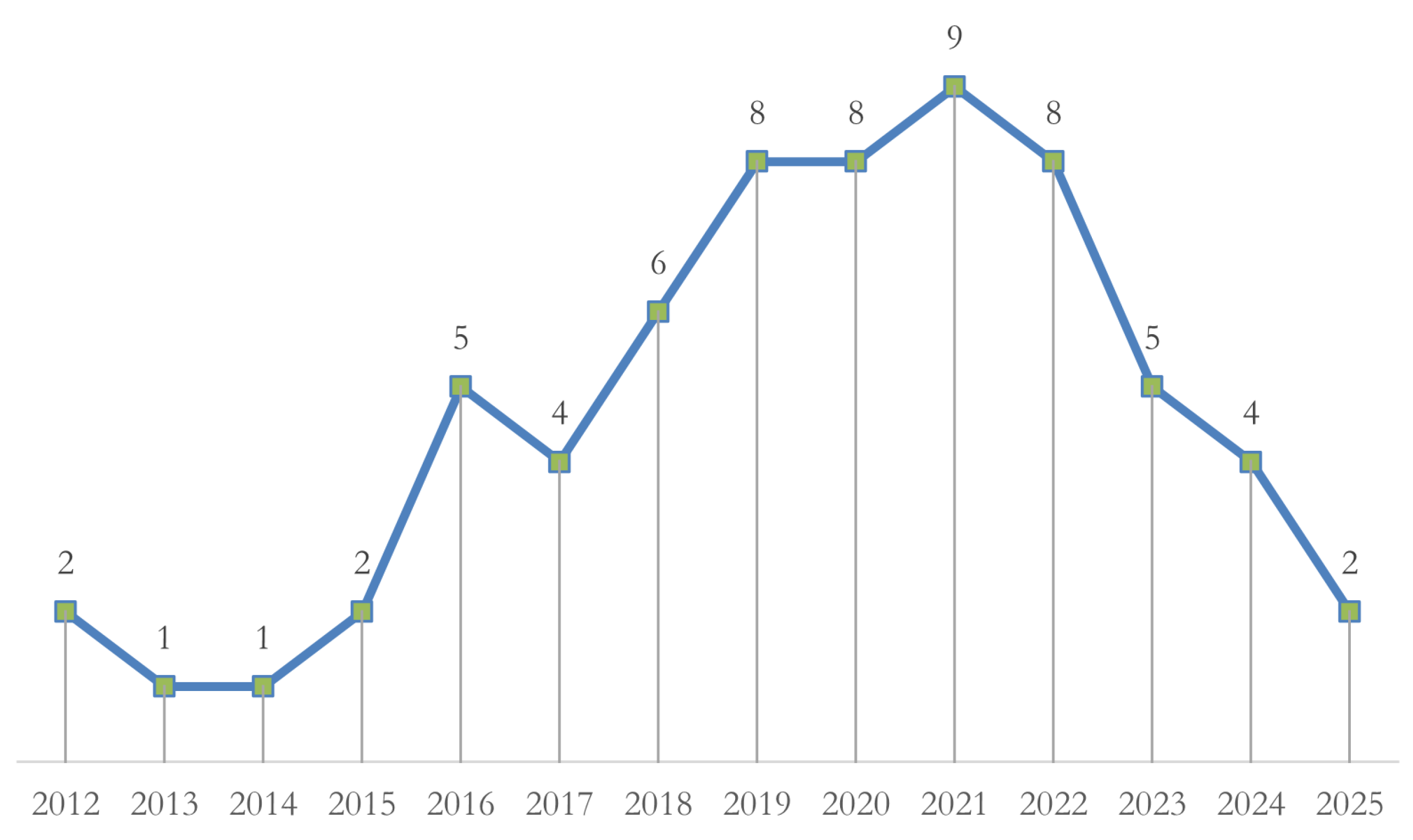
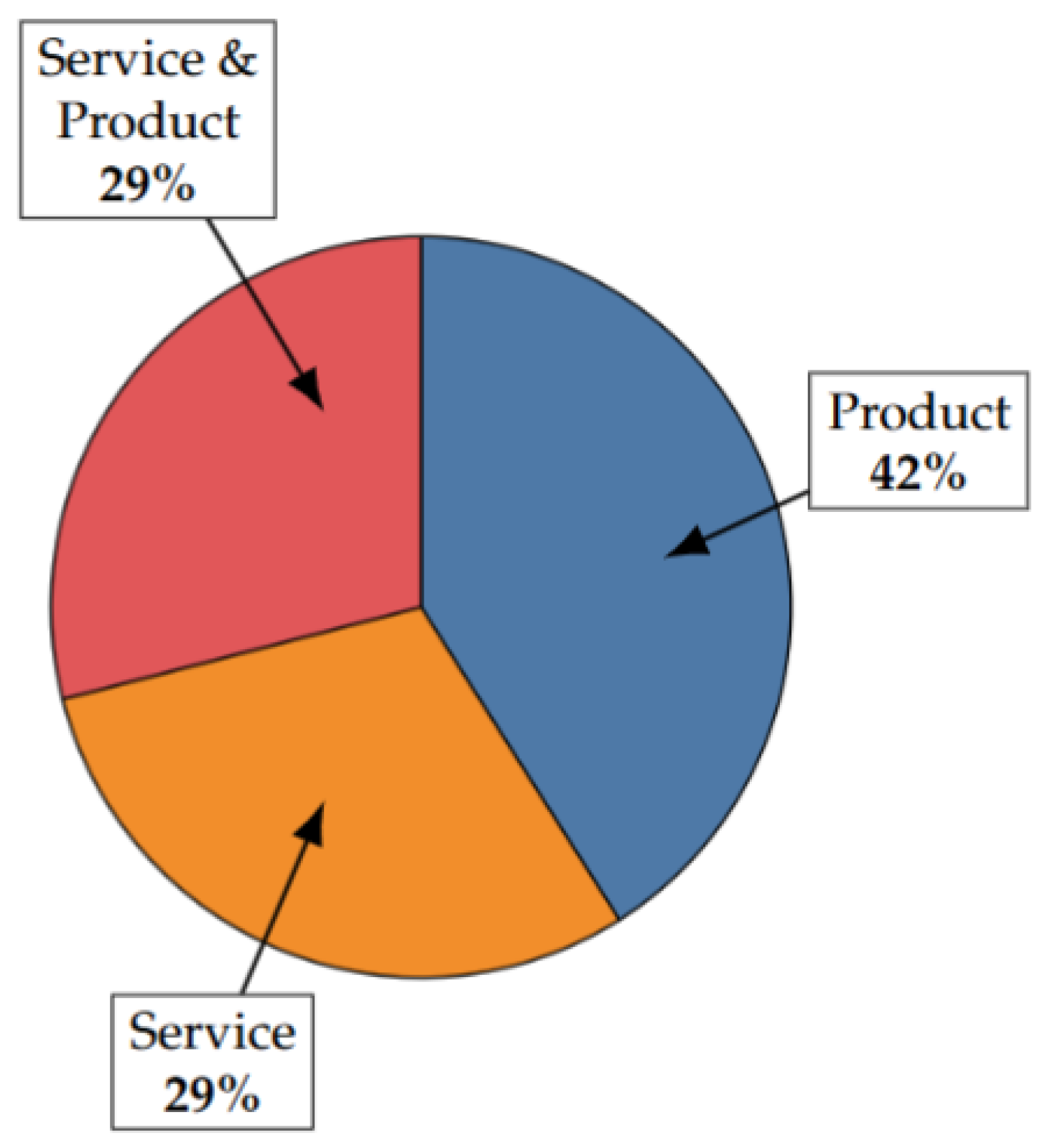
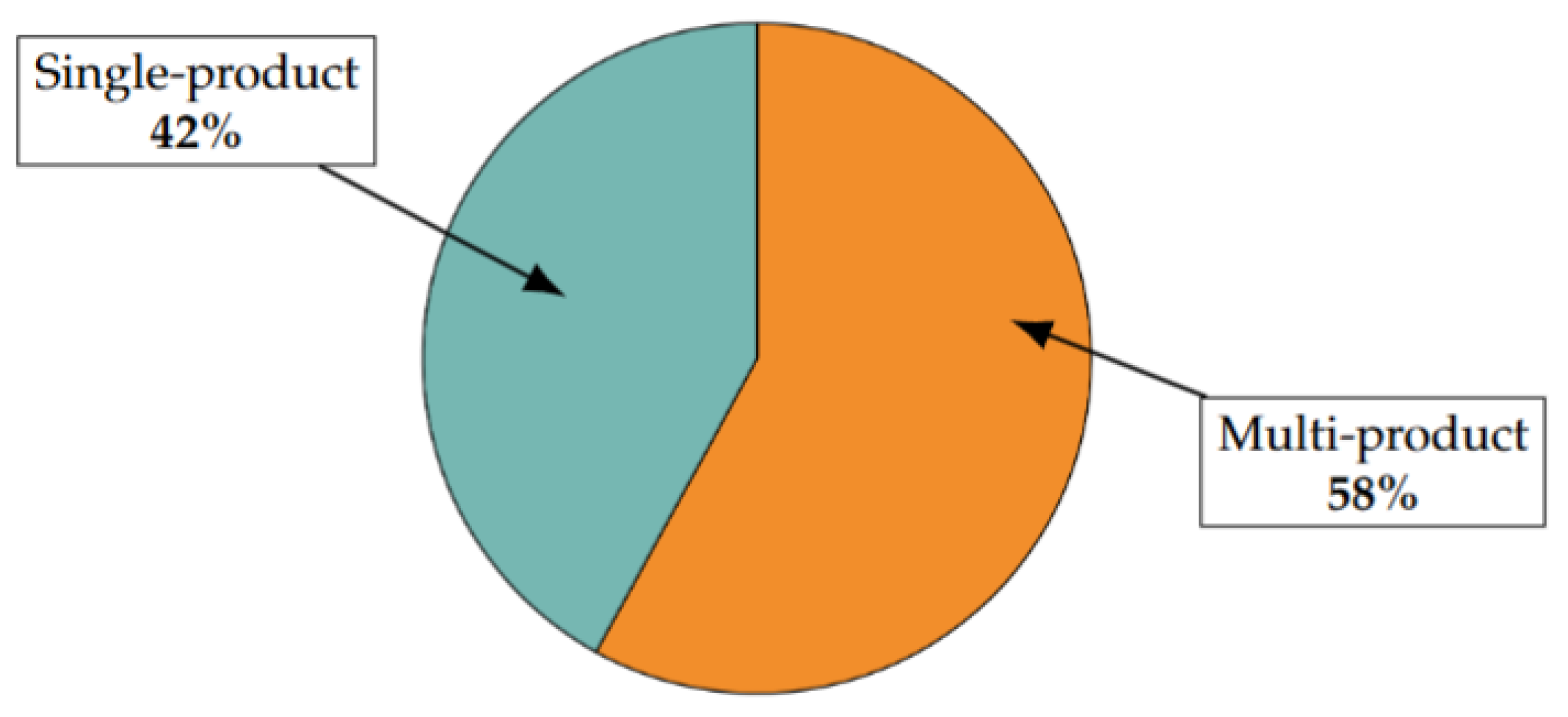
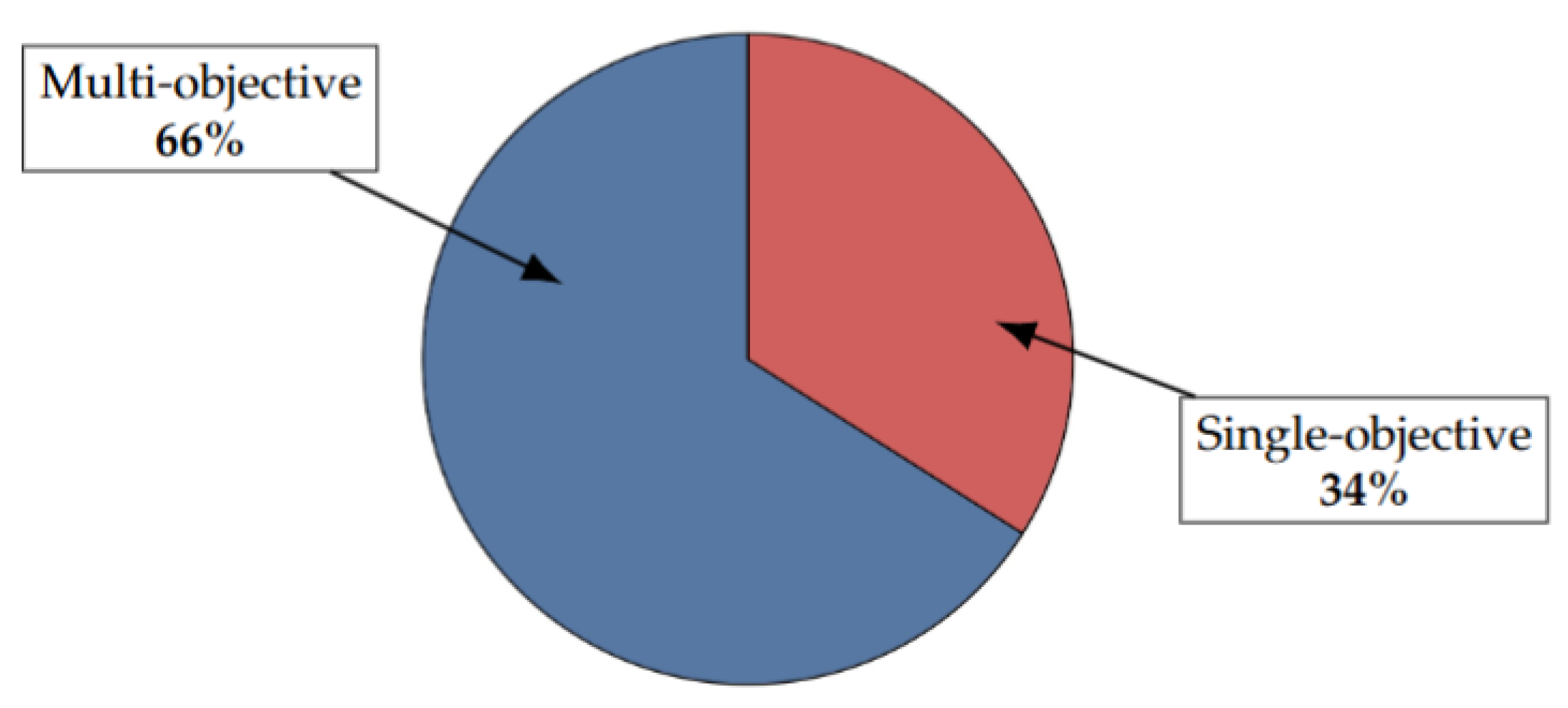
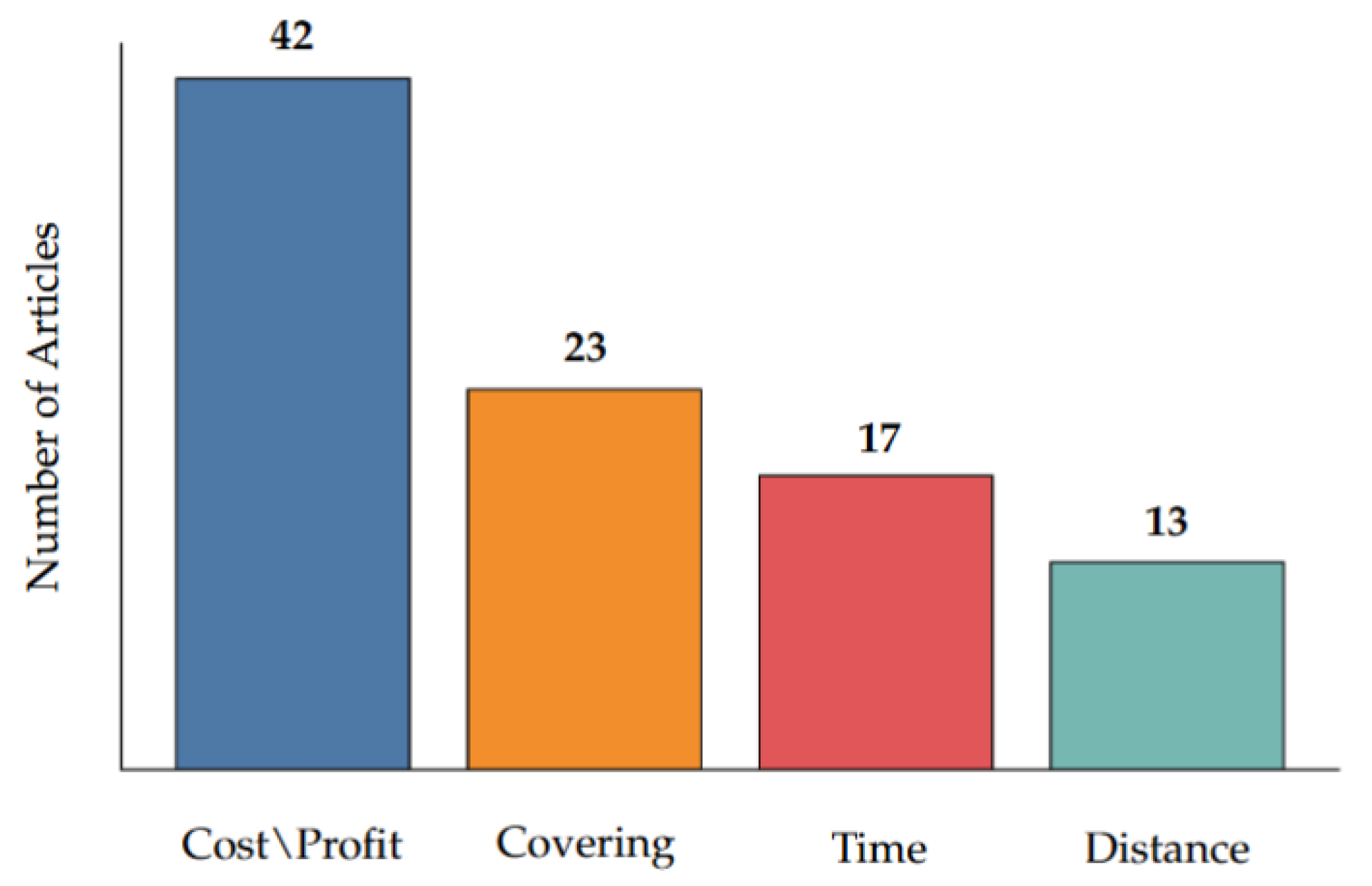

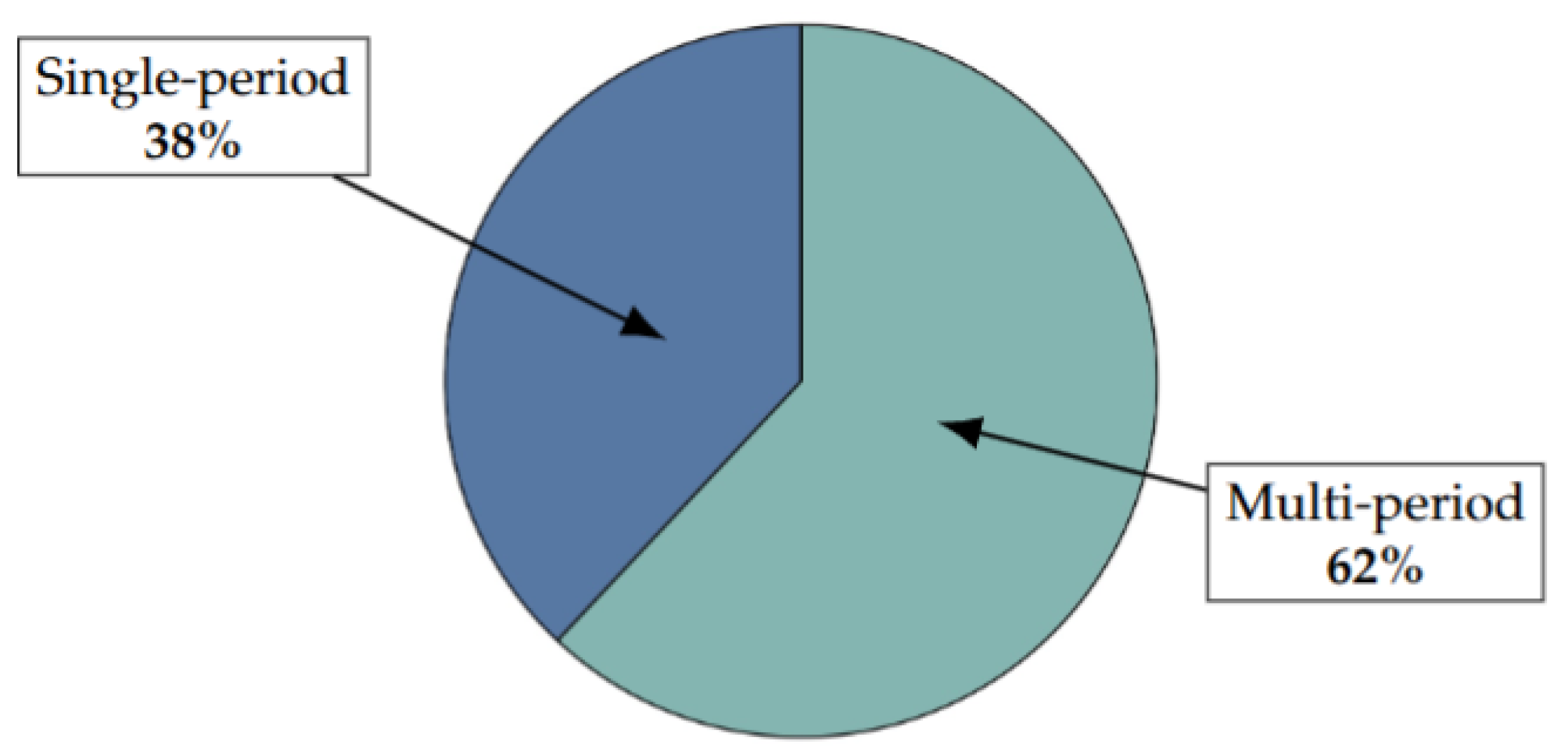

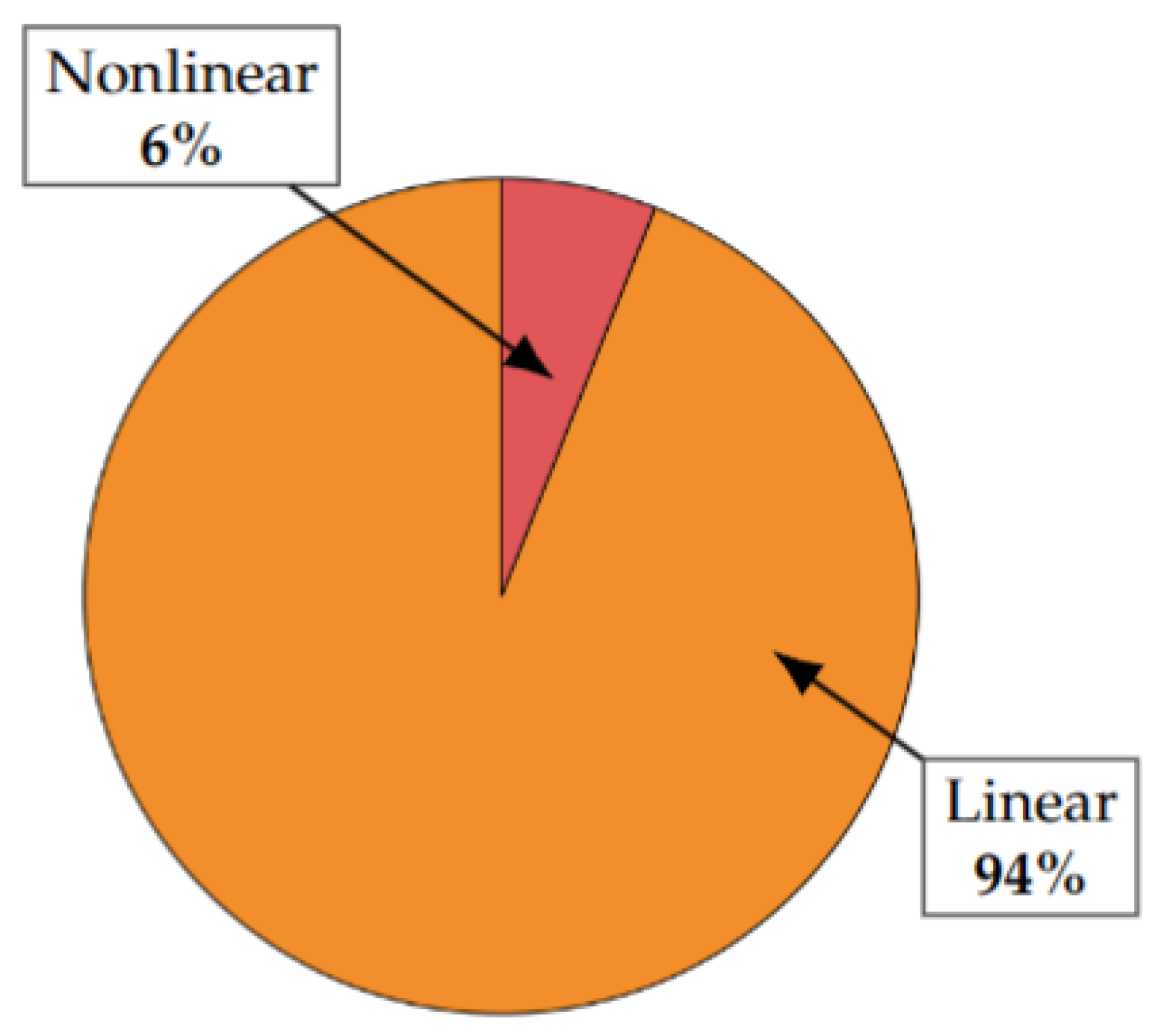
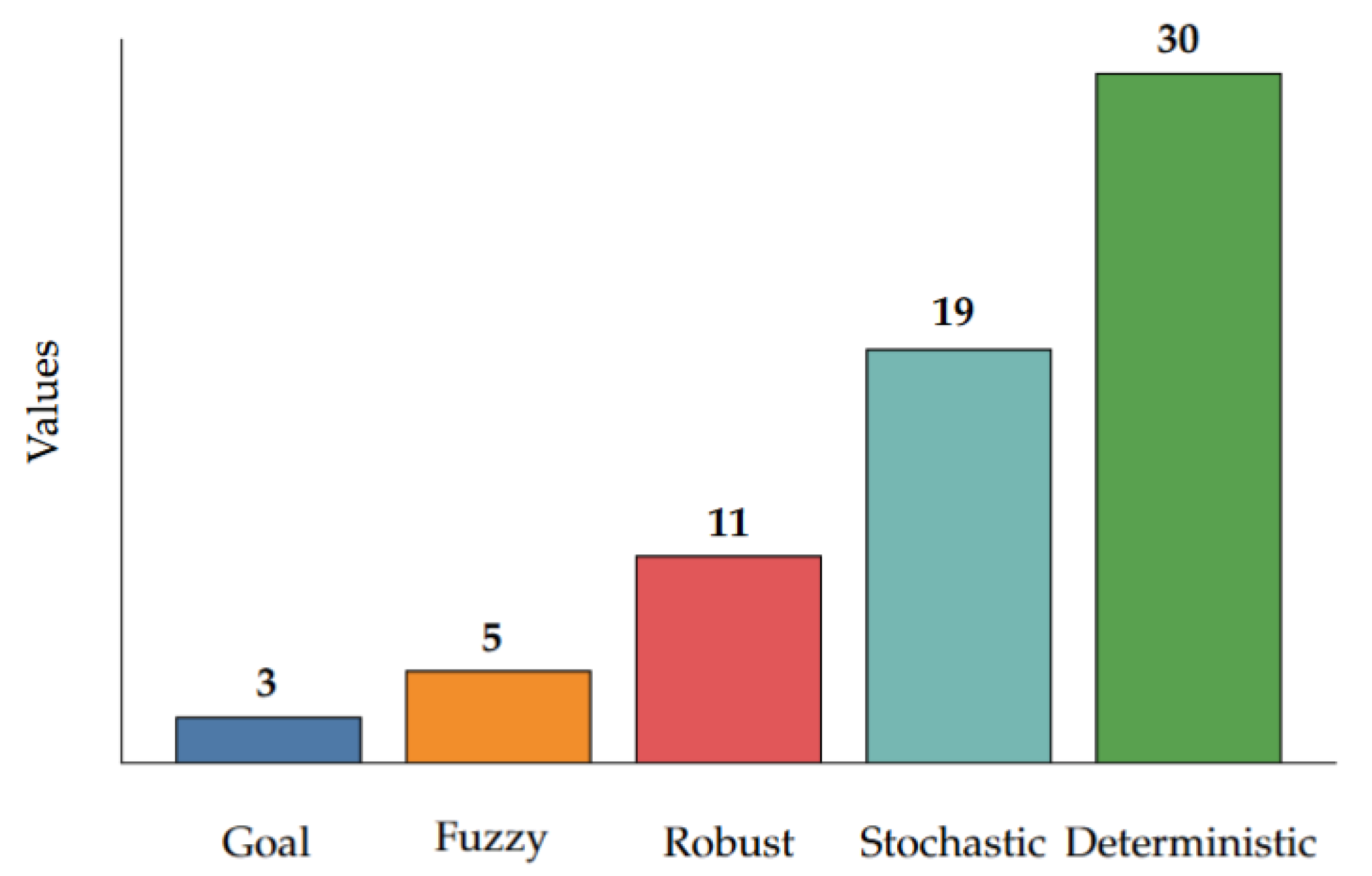
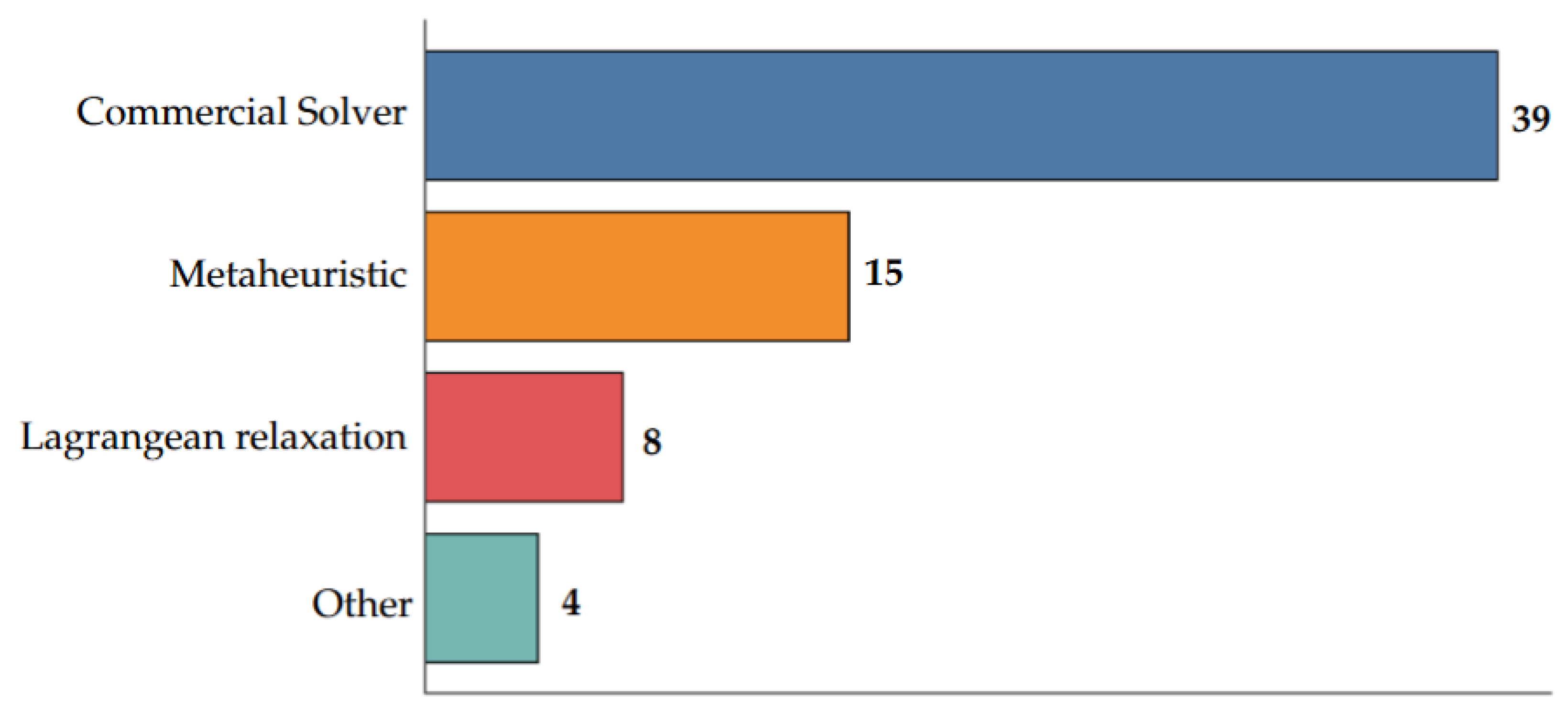

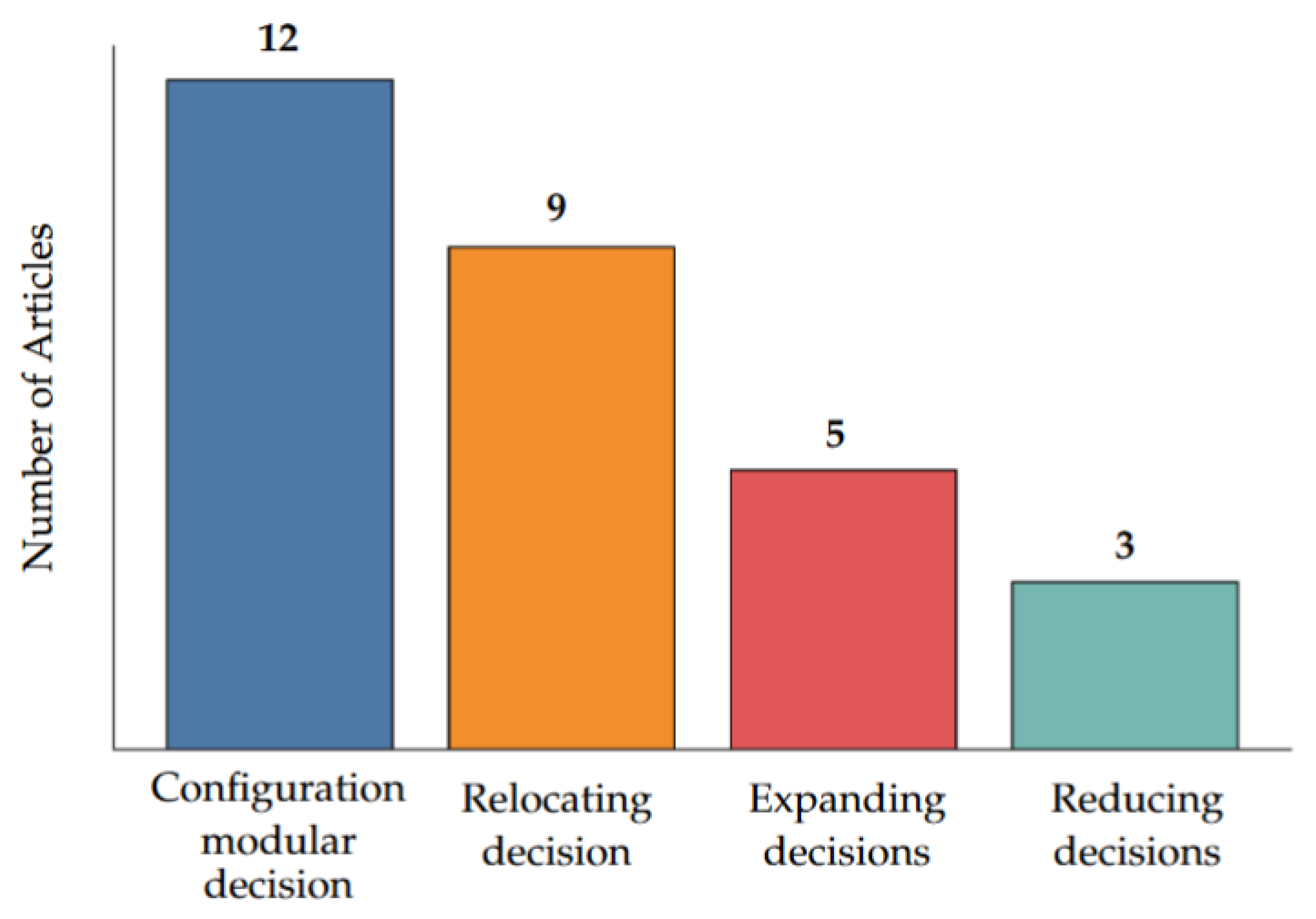
| Group | Logical Operator | Search Field | Keywords |
|---|---|---|---|
| 1 | AND | Topic | location |
| 2 | AND | Topic | tempor * OR modul * |
| 3 | AND | Topic | humanitarian OR relief OR disaster |
| 4 | AND | Topic | optimization OR model * |
| 5 | AND NOT | Topic | map * OR assess * |
| 6 | AND | Language | English |
| 7 | AND | Document Type | Article |
| Quantity | Journal |
|---|---|
| 7 | International Journal of Disaster Risk Reduction |
| 6 | Socio-Economic Planning Sciences |
| 5 | Transportation Research Part E: Logistics and Transportation Review |
| 4 | Computers and Industrial Engineering |
| 3 | International Journal of Industrial Engineering, Journal of Humanitarian Logistics and Supply Chain Management |
| 2 | Applied Sciences, European Journal of Operational Research, International Journal of Systems Science: Operations and Logistics, Journal of Combinatorial Optimization, Mathematical Problems in Engineering, Production and Operations Management |
| 1 | Annals of Operation Research, Applied Mathematical Modelling, Applied Mathematics and Computation, Environmental Science and Pollution Research, IEEE Access, Information Sciences, International Journal of Environmental Research and Public Health, International Journal of Geographical Information Science, International Journal of Industrial Engineering and Production Research, International Journal of Operations Research and Information Systems, International Journal of Production Economics, Journal of Advanced Transportation, Journal of Industrial Engineering International, Journal of Modelling in Management, Journal of Multi-Criteria Decision Analysis, Journal of Simulation, Management Science Letters, Mathematics, Naval Research Logistics, Natural Hazards, Natural Hazards Review, Operations Research for Health Care, RAIRO - Operations Research, Simulation, Transportation Research Part B: Methodological |
| Art. | Disaster | Country | Facility * | Art. | Disaster | Country | Facility * |
|---|---|---|---|---|---|---|---|
| [22] | Hurricane | USA | SC | [33] | Earthquake | Iran | CC |
| [9] | Hurricane | USA | Shelter | [34] | Earthquake | Nepal | Hub |
| [12] | Earthquake | China | Shelter | [35] | Earthquake | Turkiye | MC |
| [23] | Earthquake | China | SC | [36] | Earthquake | Turkey | Shelter |
| [25] | - | USA | DC | [37] | - | - | Shelter |
| [20] | Earthquake | Turkiye | Shelter | [38] | - | Brazil | SC, DC |
| [26] | Earthquake | Turkiye | DC | [39] | - | Japan | DC |
| [40] | Earthquake | Taiwan | MC | [41] | Earthquake | USA | DC |
| [42] | Earthquake | Iran | DC | [43] | Earthquake | China | MC |
| [31] | Earthquake | Haiti | Hub | [44] | Earthquake | China | Shelter |
| [45] | - | USA | SC | [46] | Earthquake | Pakistan | MC |
| [47] | - | - | CC | [10] | Epidemic | China | DC |
| [48] | Earthquake | Iran | MC | [49] | Flood | Thailand | SC |
| [50] | Earthquake | USA | MC | [51] | Earthquake | China | MC |
| [52] | earthquake | Haiti | MC | [53] | Earthquake | Iran | Shelter |
| [54] | Tsunami | Korea | Shelter | [55] | Earthquake | Mexico | DC |
| [56] | Earthquake | Iran | CC | [19] | Refugee | Turkiye | School |
| [57] | Earthquake | Iran | Shelter | [24] | Flood | Bangladesh | SC |
| [27] | - | - | DC | [58] | Earthquake | Iran | MC |
| [11] | Earthquake | Nepal | Hub | [59] | Epidemic | China | DC |
| [60] | Flood | India | Shelter | [29] | Earthquake | China | MC |
| [61] | Earthquake | Turkiye | MC | [30] | Earthquake | China | MC |
| [62] | Earthquake | Nepal | SC | [63] | Epidemic | Turkiye | MC |
| [64] | Earthquake | Iran | MC, Shelter | [65] | - | Iran | CC |
| [21] | - | Syria | Shelter | [4] | Epidemic | Iran | MC, DC |
| [28] | Earthquake | China | MC | [66] | Epidemic | China | DC |
| [32] | Earthquake | Nepal | Hub | [67] | Epidemic | China | DC |
| [68] | Earthquake | - | SC | [69] | - | - | CC |
| [70] | Earthquake | Nepal | Shelter | [71] | Earthquake | Iran | MC, PC |
| [72] | - | Japan | DC | [73] | Earthquake | Iran | MC |
| [74] | Earthquake | Turkiye | DC | [75] | Earthquake | Turkiye | MC |
| [76] | Earthquake | Iran | MC, DC | [77] | Earthquake | Iran | CC |
| [78] | Earthquake | Turkiye | MC |
| Main Problem | Strategy |
|---|---|
| Unexpected surge in demand exceeding the available capacity | - Establishment of temporary facilities in strategic locations to provide immediate assistance to affected populations. |
| - Implementation of temporary logistical hubs and storage centers to enhance coordination and streamline the supply chain. | |
| Dynamic and evolving demand in post-disaster scenarios | - Development of adaptive planning models incorporating multi-period planning horizon. |
| - Adoption of modular capacity strategies to allow for flexible scaling, ensuring expansion or reduction of capacity as needed. | |
| - Consideration of facility relocation strategies. | |
| Operational challenges in the immediate response phase | - Utilization of multi-objective optimization models to minimize response time, maximize coverage, and minimize cost simultaneously. |
| - Integration of uncertainty modeling techniques, including stochastic, robust, and fuzzy logic approaches, to enhance decision-making under unpredictable conditions. | |
| - Due to the complexity of mathematical models, consideration of more advanced solution approaches. | |
| Lack of consideration for the temporary nature of emergency facilities | - Strategic planning for the timely closure of temporary facilities to maximize efficiency and sustainability. |
| Need to collect, classify, sort, conduct quality control, and package donations | - Implementation of temporary collection and processing centers. |
| Trends | Gaps |
|---|---|
| -Publication of articles in journals on humanitarian logistics | -Lack of integration in article publications among OR researchers, HL researchers, and HL practitioners |
| -Temporary facility location in earthquake immediate response in Asian countries | -Lack of studies on temporary facility location in sudden-onset disasters considering logistical and sociopolitical contexts |
| -Lack of studies on temporary facility location in human-induced or slow-onset disasters | |
| -Lack of studies on facility location during the reconstruction phase or integrating response and reconstruction phase | |
| -Temporary facility location in the last mile (shelters, medical centers, distribution centers) | -Lack of research on the location of collection (including sorting operations) and processing centers |
| -Limited research on the location of temporary logistic hubs for coordination and efficiency | |
| -Need for models integrating multi-purpose facilities | |
| -Use of a multi-product approach, primarily food and medical supplies | -Need to consider adapted facilities for specialized products, such as those related to blood. |
| -Use of deterministic models and commercial solvers | -Lack of consideration of stochastic, fuzzy, and robust approaches, as well as heuristic solutions and relaxations |
| -Mathematical models for temporary facility location problems considering a multi-objective linear approach and multi-period planning | -Need to incorporate modularity strategies and module relocation in multi-period planning |
| -Need to develop nonlinear models, considering that deprivation costs are inherently nonlinear. | |
| -Mathematical modeling considering capacity constraints | -Lack of analysis on the expansion and reduction capacity of temporary facilities based on demand fluctuations |
| -Only opening decisions in temporary facility location problems | -Lack of studies on both opening and closing decisions in temporary facility location problems |
| -Use of standard temporary facilities | -Need to use modular temporary facilities for better adaptability and flexibility |
Disclaimer/Publisher’s Note: The statements, opinions and data contained in all publications are solely those of the individual author(s) and contributor(s) and not of MDPI and/or the editor(s). MDPI and/or the editor(s) disclaim responsibility for any injury to people or property resulting from any ideas, methods, instructions or products referred to in the content. |
© 2025 by the authors. Licensee MDPI, Basel, Switzerland. This article is an open access article distributed under the terms and conditions of the Creative Commons Attribution (CC BY) license (https://creativecommons.org/licenses/by/4.0/).
Share and Cite
Carnero Quispe, M.F.; Chambilla Mamani, L.D.; Yoshizaki, H.T.Y.; Brito Junior, I.d. Temporary Facility Location Problem in Humanitarian Logistics: A Systematic Literature Review. Logistics 2025, 9, 42. https://doi.org/10.3390/logistics9010042
Carnero Quispe MF, Chambilla Mamani LD, Yoshizaki HTY, Brito Junior Id. Temporary Facility Location Problem in Humanitarian Logistics: A Systematic Literature Review. Logistics. 2025; 9(1):42. https://doi.org/10.3390/logistics9010042
Chicago/Turabian StyleCarnero Quispe, María Fernanda, Lucciana Débora Chambilla Mamani, Hugo Tsugunobu Yoshida Yoshizaki, and Irineu de Brito Junior. 2025. "Temporary Facility Location Problem in Humanitarian Logistics: A Systematic Literature Review" Logistics 9, no. 1: 42. https://doi.org/10.3390/logistics9010042
APA StyleCarnero Quispe, M. F., Chambilla Mamani, L. D., Yoshizaki, H. T. Y., & Brito Junior, I. d. (2025). Temporary Facility Location Problem in Humanitarian Logistics: A Systematic Literature Review. Logistics, 9(1), 42. https://doi.org/10.3390/logistics9010042






